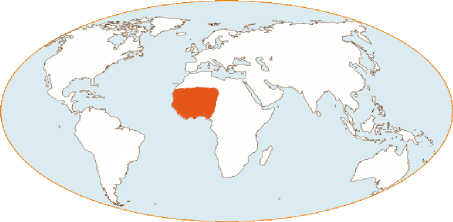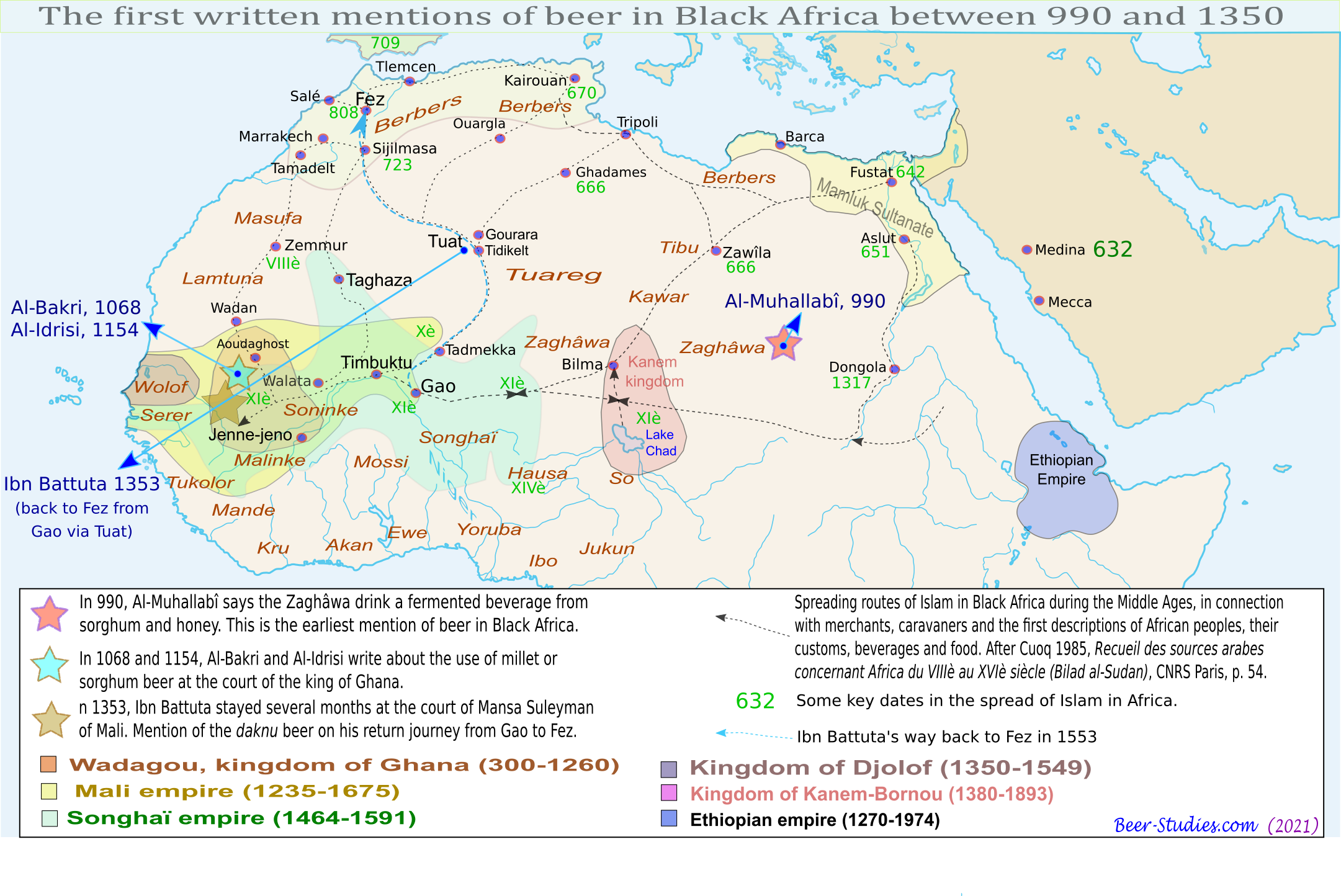Beer brewing in the earliest African kingdoms (9th to 13th century).
Three major African confederations successively dominated West Africa between the 9th century and the 16th century. The Empire of Ghana (830-1235), the Empire of Mali (13-14th centuries) and the Songhai Empire (15-16th century). These empires federate kingdoms and chieftaincies under the authority of a mansa, a king more powerful than the others and acknowledged by them. This federating political power is endowed with military, legal and economic power. These empires dominated and organised very large territorial units from present-day Senegal to the Niger basin and up to Tchad Lake.
According to the Tarikh es Soudan (History of Sudan), Ghana was founded in the 3rd century by the black Soninke farmers. In the 7th century, Al Farazi is the first to quote the "Ghâna, land of gold". In medieval times, Arab historians and geographers reached the Lake Chad bordered by the African kingdoms of Bornou and Kanem. They criss-cross North Africa, its coastal western strip as far as the Senegal River and penetrate into the former empire of Ghana. Later, they will visit the empire of Mali and its successor the empire Songhaï.
In 734, the first Arab-Berbers entered Ghana, where Soninke rulers dominated an entire region comprised between the present day coast of Senegal and the sources of the Niger river. The occupation of the Maghreb by the Arabs favours the gold and slave trade between the kingdom of Ghana and the Sijilmassa (a Berber merchant city in the oasis of Tafilalt, at the northern border of Morocco along with the Sahara), and at the same time, its expansion and wealth. Over the centuries, this North-South trade across the sub-Saharan barrier will take on a continental dimension. Many Berber and Arab merchants drive their caravans into the heart of Black Africa, returning with their descriptions of the mores and customs of African peoples.
In 903, Ibn al-Fakir reports that " The people of the country (Ghana) feed on millet (dhurra) and doliques (beans). They call millet dukhn. They dress themselves in panther skins which are very numerous in this place."[1].
In 990, Al-Muhallabî describes the beverage of the king of the Zaghawa, a kingdom established towards Lake Chad at that time. It is the oldest mention of sorghum beer sweetened with honey for black Africa, if we except the Egyptian testimonies :
"They worship their king and they worship him in the place of God, the Most High. They say that he takes no food. But his food is brought secretly to his house by his own people, no one knowing where they get it from. If a passer-by happens to come across the camel carrying the (royal) provisions, he is killed on the spot. The king drinks with his intimates a beverage made with sorghum and strongly prepared with honey. ... The crops of the country are mainly millet and beans and then wheat (sorghum?)" (Cuoq 78).
The Zaghawa, east of the Niger loop, are not part of the Ghana confederation. But this quotation clarifies how royalty works in Africa: the king drinks and eats the same food as his people, but separately from them. There is no difference in nature or quality between the beer of the royal family and that of the people. The royal status is expressed in the secrecy that surrounds his meals, protecting him from poisoning and evil spells.
The Andalusian geographer Al-Bakri (1014~1094) is famous for his Book of Routes and Kingdoms written in 1068. It is full of details about the social life of the Sudan, the name the Arabs gave to the inhabitants of Black Africa. It tells of the funeral of a king of Ghana:
"At the death of a king, they erect a huge dome made of sadj wood over his grave. The body is brought there and placed on a stretcher furnished with a few carpets and cushions. They place near the deceased his ornaments, weapons and personal belongings to eat and drink with food and beverages. Several of his cooks and beverage makers are locked up with him. Once the door is closed, mats and canvases are placed on the mound."
Al-Bakri describes the burial of the king's servants for its funeral. The king has his own cooks and brewers - the royal beverage is sorghum beer as among the Zaghawa - who will serve him in the afterlife.
" The entire assembled crowd covers the tomb with earth, which gradually becomes like an impressive mound. A ditch is then dug all around, leaving a passage to access the tomb. It is customary for them to offer sacrifices and libations (khumur) to their dead." (Cuoq 100).
These libations also consist of beer.
The scene evokes the economic and political power of the Ghana, a powerful confederation of kingdoms and chieftaincies which dominated the valleys of Upper Niger and Upper Senegal at that time. The king levied taxes on salt and copper. He retains for himself the gold trade with the Maghreb. Al-bakri says that:
« The king of Ghana can set up 200,000 men and more than 40,000 archers for war. The horses of Ghâna are very small in size. One finds excellent (false) ebony. One sows twice a year: at the flood of the Nile[2] and at the wet season".
The power of Ghâna collapsed around 1077 under the blows of the Almoravids who had come from present-day Morocco to conquer the lands of the Middle Niger and raid its gold mines.
In 1154, the Moroccan-born geographer Al-Idrisi (1099~1166) describes a weakened king of Ghana who had converted to Islam. And still for the inhabitants :
"No wheat in their land but a lot of sorghum, of which they make a fermented beverage that they drink"(Cuoq 132).
This time it is an ordinary beer and not the royal or funeral beverage. Arab, Andalusian and Moroccan geographers gathered their information from the Muslim merchants and caravanners who stayed close to the African king in his capital. The customs of the peoples of the confederacy are not well known.
Thus, Ibn Sa'id al-Maghribi (or Ibn Sa'id al-Andalusi) born near Granada in 1208, died in Damascus or Tunis (1274 or 1286), tireless traveller, becomes even more vague than Al-Idrisi about the African beverages :
"Their food usually consists of different kinds of beans (kataniya) , broths or fermented things. No bread at home, except somewhat among the chiefs educated in the manner of the whites." (al-bid, i.e. North Africans), (Cuoq 204).
Founded by Sundiata Keita (1217~1255), the empire of Mali (or Mandingue) succeeded the then moribund Ghana around 1230. This empire controls a territory as vast as the former Ghana between the basins of Senegal and Niger. In 1352, Ibn Battuta (1304~1377) leaves Fez to go to Niani, capital of the empire of Mali. He frequents several months the court of the Mansa, sovereign of the other kings of the region. On the way back, he passes through the cities of Timbuktu and Gao in the loop of the Niger, before going north to reach Fez via the Touat. There, he notes this:
"They then brought one their beverage known as daknu - a water containing crushed sorghum, mixed with a little honey or sour milk. They drank this instead of water because, for them, drinking pure water hurts them. If they can't find sorghum, they mix (the water) with honey or sour milk."
Is this about beer that Ibn Battuta knows about? Under the pen of a Muslim who has drunk it, there can be no question of an alcoholic beverage. Technically, the daknu the great traveller is talking about is a beer, although very little fermented. This sorghum infusion, which has become sweet (acidifying action of the sour milk), ferments spontaneously (yeasts brought by the honey). Centuries later, in 1828, René Caillé, first westerner to reach Timbuktu, has drunk a semi-fermented sorghum beverage on the banks of the Niger that closely resembled Ibn Battuta's doknu (beer and Muslim world).
Not far away, in the Niger loop, the Dogons have inhabited the cliffs of Bandiagara in Mali since the 15th century. Sorghum beer is omnipresent in the material and social life of the Dogons, their religion and their myths. The place of beer in the Dogon world has been the subject of many studies[3]. Excavation of the cliffs in the Sanga region, in particular the rock shelters reused as necropolises, has made it possible to date and characterise the Tellem culture. It preceded that of the Dogons in this region and used these shelters between the 11thth and 16thth century, the time of its extinction or absorption by the Dogons. One finds Tellem pottery of forms comparable to the éru (large beer jar) and buno (beer jar) of the Dogons, with the exception of the decoration. The Tellem would be the beer drinking ancestors of the Dogons in the Sanga region[4].
[1] Cuoq Joseph 1985, Recueil des sources arabes concernant l'Afrique occidentale du VIIIè au XVIè siècle (Bilad al-Sudan), CNRS Paris, p. 54.
[2] Arab geographers believe at the time that the basins of Niger and Nile met, the Niger River being the source of the Nile. It is not known that the course of the Niger then bends southwards before Lake Chad. A later version makes Lake Chad the source of both rivers, with the Nile flowing eastwards and the Niger westwards, a version that became aberrant when Ibn Battuta testified in the 14th century that the Niger River is flowing eastwards near Timbuktu and Gao.
[3] Eric Jolly 2004, Boire avec esprit. Bière de Mil et Société Dogon. Société d'ethnologie, Nanterre. Germaine Dieterlen, Geneviève Calame-Griaule 1960, L'alimentation dogon, Cahiers d’Études africaines, 1(3):46–89. persee.fr/web/revues/home/prescript/article/cea_0008-0055_1960_num_1_3_2947
[4] Bedaux, Lange 1983, Tellem, reconnaissance archéologique d'une culture de l'Ouest africain au moyen âge : la poterie. Journal des Africanistes 53, 1-2 : 5-59. persee.fr/web/revues/home/prescript/article/jafr_0399-0346_1983_num_53_1_2037




